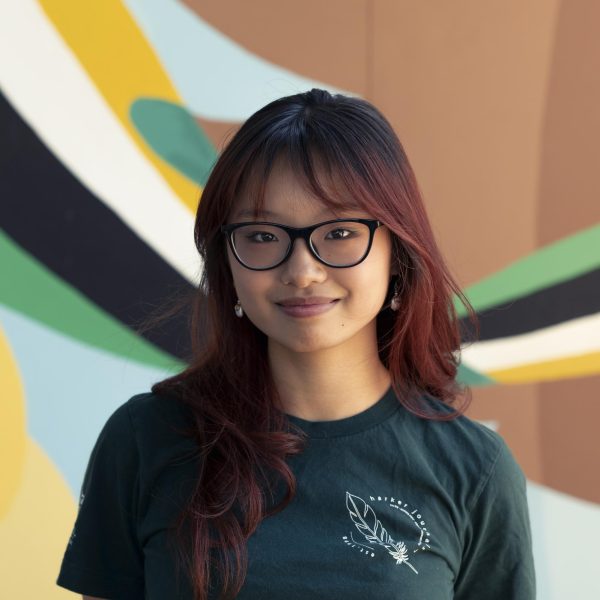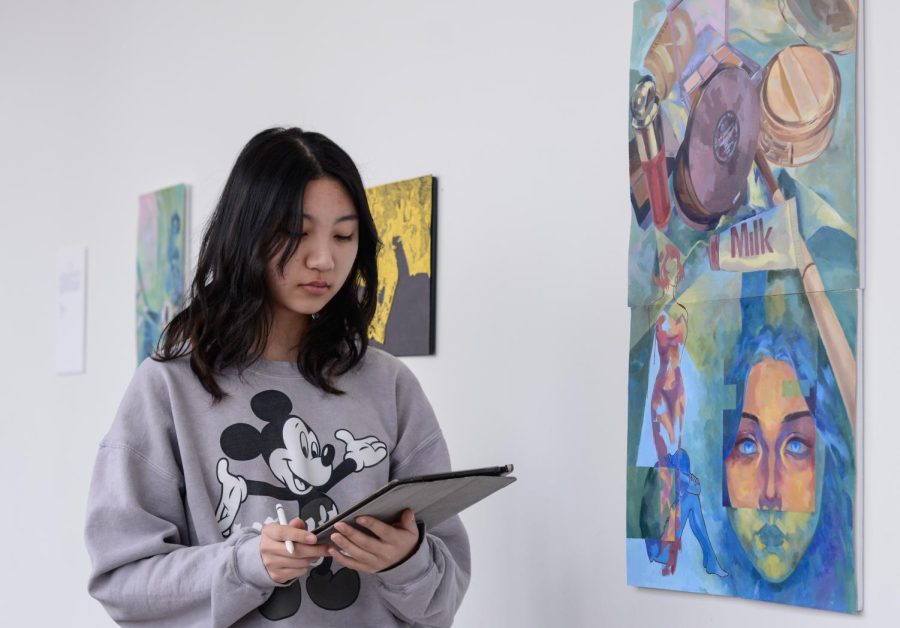Humans of Harker: Coloring in the gaps
Sonya He fuses artistry with care and emotion
“My parents told me, ‘You can’t change anything about yourself.’ Despite how good it feels when people enjoy what I make, I don’t want to trap myself in the mindset of depending on others for validation. I have to accept who I am,” Sonya He (12) said.
To create is peculiar.
In one sense, everything is simply an amalgamation of past materials and experiences, and nothing is ever truly new. But by infusing narrative and intention, one can distinguish creations.
With the stroke of a brush and the clack of a stylus, Sonya He (12) embodies creativity. Her artistic career began small — both in age and in the paper crafts and sewing projects she devised. Sonya soon began attending a traditional studio weekly, sketching still life. As she grew older, the focus in her work shifted from mastering technique to mastering expression. When visiting a new studio in middle school, Sonya recalls how a teacher’s critique of her cat drawing as “uninspired” sparked a realization that creativity, though often perceived as immutable and innate, was improvable, just like any other skill.
“My art is all about communication in an indirect way,” Sonya said. “Having other people understand a message you’re trying to send is a pretty good feeling, and I really want to push that.”
Sonya’s extensive experience in traditional art techniques serves as a launching pad for these messages, whether she works on digital art, painting or her newest foray, animation. Regardless of medium, Sonya’s distinct grasp of color shines. She notices and admires intentional and often subversive color choices such as those in the work of online artist @bumskee.
Her dedication doesn’t go unnoticed. Behind upper school art teacher Pilar Aguero-Esparza’s desk hangs a colored pencil drawing of a dollar bill, a piece she bought from Sonya after being amazed by the skill she demonstrated in her Advanced Drawing class. For the past three years, Aguero-Esparza has mentored Sonya, observing the evolution of her work in Art Club, her investigation of the dream state through AP Studio Art and her exploration of perception through Honors Directed Portfolio.
“Sonya has a very intuitive sense,” Aguero-Esparza said. “She understands the way color works and composition very naturally. Looking at her work, you don’t feel like an outsider. You are the person who is in the painting, experiencing it.”
Sonya creates catharsis. Cutoff body parts coated in the hazy nostalgia of memories, Sonya’s portfolio last fall centered around the feeling of being a foreigner inside one’s own body, especially in the context of social media’s smoke-and-mirrors effect on aesthetic standards. She cites social media as both a source of inspiration and learning as well as insecurity.
Like many others during the pandemic, Sonya used apps like Instagram more, finding herself trapped in an unhealthy cycle of posting, comparing and archiving. By largely extracting herself from social media, she began to develop an “it is what it is” attitude towards her perceived shortcomings, learning to focus on only what is within her own control.
“Social media’s influence on self perception is a huge problem in our generation,” Sonya said. “People aren’t able to see how they truly are because of this warped lens they see others through. In turn, it has a very negative impact on how we view ourselves.”
Pivoting the focus from the intricacies of Sonya’s relationship with herself to her relationship with others, one can clearly observe the mutual respect and harmonious chemistry woven into Sonya’s friendships. Close friend and fellow Art Club member Austina Xu (12) reflects on her relationship with Sonya, one that grew from memories formed in shared classes and Art Club projects.
“In middle school I held a lot of respect for her,” Austina said. “I still view her as a role model. I admire how she just does what she wants. Sometimes that means forgotten homework and late nights drawing, but I respect people who are unapologetic about doing things they love. She’ll always be someone I look up to.”
Close friend Johnny Kuehnis (12) appreciates both Sonya’s complete devotion to her art and her wholehearted dedication to the people and activities she loves. Johnny reminisces on their friendship, which strengthened over late night calls while Sonya worked on her AP portfolio.
“It’s not often you meet someone who’s just so genuine, so kind-hearted,” Johnny said. “Sonya is someone who will be there for you, someone who’s fun, who really is the complete package. I’m thankful I get to see her grow into this amazing person she’s today. I’m very lucky to have her in my life as someone I’m close with.”
Sonya creates acceptance. In the doodles between her notes, the spreads and posters she designs, the countless pages of thumbnail sketches, the fond look anyone speaking of her dons, Sonya’s understated but ever-present sense of self is infectious.
“I hope to be someone who is willing to share my ideas with others while also becoming more accepting of myself,” Sonya said. “Those are my own core values, and sharing is a huge party of it.”
As she speaks of her next project, the new technique she wants to try or embarrassing stories of youth, her balancing act of confidence and relatability leaves one hanging onto every word.
“My parents told me, ‘You can’t change anything about yourself,’” Sonya said. “Despite how good it feels when people enjoy what I make, I don’t want to trap myself in the mindset of depending on others for validation. Even if I don’t like a part of myself, I have to accept who I am.”

Alison Yang (12) is an Editor-in-Chief of Harker Aquila, and this is her fourth year on staff. This year, she looks forward to bonding with everyone on...


















![“[Building nerf blasters] became this outlet of creativity for me that hasn't been matched by anything else. The process [of] making a build complete to your desire is such a painstakingly difficult process, but I've had to learn from [the skills needed from] soldering to proper painting. There's so many different options for everything, if you think about it, it exists. The best part is [that] if it doesn't exist, you can build it yourself," Ishaan Parate said.](https://harkeraquila.com/wp-content/uploads/2022/08/DSC_8149-900x604.jpg)




![“When I came into high school, I was ready to be a follower. But DECA was a game changer for me. It helped me overcome my fear of public speaking, and it's played such a major role in who I've become today. To be able to successfully lead a chapter of 150 students, an officer team and be one of the upperclassmen I once really admired is something I'm [really] proud of,” Anvitha Tummala ('21) said.](https://harkeraquila.com/wp-content/uploads/2021/07/Screen-Shot-2021-07-25-at-9.50.05-AM-900x594.png)







![“I think getting up in the morning and having a sense of purpose [is exciting]. I think without a certain amount of drive, life is kind of obsolete and mundane, and I think having that every single day is what makes each day unique and kind of makes life exciting,” Neymika Jain (12) said.](https://harkeraquila.com/wp-content/uploads/2017/06/Screen-Shot-2017-06-03-at-4.54.16-PM.png)








![“My slogan is ‘slow feet, don’t eat, and I’m hungry.’ You need to run fast to get where you are–you aren't going to get those championships if you aren't fast,” Angel Cervantes (12) said. “I want to do well in school on my tests and in track and win championships for my team. I live by that, [and] I can do that anywhere: in the classroom or on the field.”](https://harkeraquila.com/wp-content/uploads/2018/06/DSC5146-900x601.jpg)
![“[Volleyball has] taught me how to fall correctly, and another thing it taught is that you don’t have to be the best at something to be good at it. If you just hit the ball in a smart way, then it still scores points and you’re good at it. You could be a background player and still make a much bigger impact on the team than you would think,” Anya Gert (’20) said.](https://harkeraquila.com/wp-content/uploads/2020/06/AnnaGert_JinTuan_HoHPhotoEdited-600x900.jpeg)

![“I'm not nearly there yet, but [my confidence has] definitely been getting better since I was pretty shy and timid coming into Harker my freshman year. I know that there's a lot of people that are really confident in what they do, and I really admire them. Everyone's so driven and that has really pushed me to kind of try to find my own place in high school and be more confident,” Alyssa Huang (’20) said.](https://harkeraquila.com/wp-content/uploads/2020/06/AlyssaHuang_EmilyChen_HoHPhoto-900x749.jpeg)



